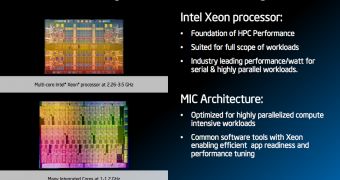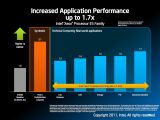With the desktop version of its Sandy Bridge-E processors out and about, Intel is now focusing its attention towards the server version of these chips, the Xeon E5, and has recently provided the press with a series of new details about these CPUs.
Intel's Xeon-E5 processors are supposed to replace the company's current Xeon 5000-series CPUs and judging by the data provided by Intel these should deliver an impressive jump in performance.
According to the Santa Clara chip maker, in synthetic benchmarks an eight-core Xeon E5 CPU running at 2.7GHz should be more than twice as powerful as an Xeon X5690 six-core chips that runs at 3.46GHz.
In real life scenarios, the performance difference between the two server parts won't be as high, but Intel still promises a minimum speed increase of 30%, while in some applications the Xeon E5 could prove to be up to 70% faster than its predecessor.
From the information leaked until now (some of which was published by ComputerBase), we know that the Xeon E5 range will be split into more than one CPU lines for single as well as multi-socket systems.
Intel's Xeon E5 chips will support between four and eight computing cores with TDPs ranging from 50W to 130W, and include all the technologies that come standard with the Sandy Bridge architecture such as support for the AVX instruction set.
Depending on the socket used, Xeon E5 processors can also pack a tri- or quad-channel memory controller, up to 20MB of Level 3 cache memory, 2 QPI links, 40 PCIe Gen3 lanes, and four DMI 2.0 lanes.
Intel is sampling this chips right now to a select number of cloud and HPC computer vendors, but mass availability isn't expected to be reached until the first quarter of next year.

 14 DAY TRIAL //
14 DAY TRIAL // 
